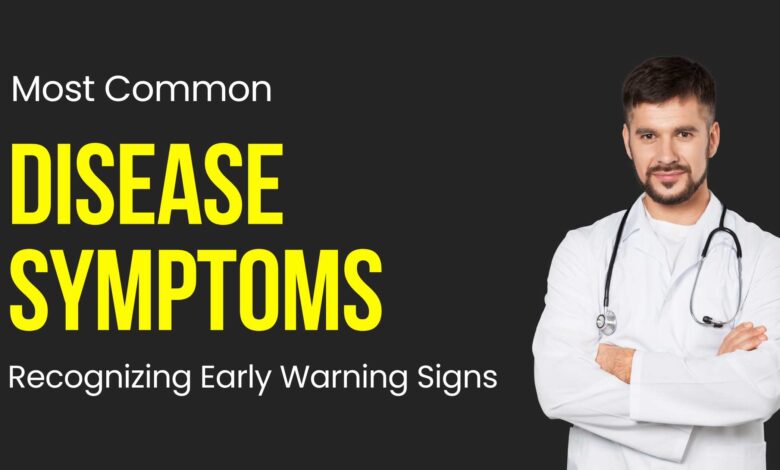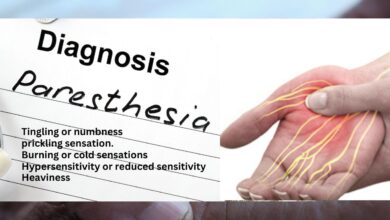
The human body is a complex and amazing machine that gives clues about its inner state. These symptoms can be symptoms or early warning signs of health problems. Identifying and interpreting these symptoms allows timely intervention and better health outcomes. This article discusses some of the most common symptoms of the disease, categorized by body system, and emphasizes the importance of consulting a health professional for diagnosis and treatment.
Table of Contents
Know your symptoms: A window into your health
Symptoms are subjective experiences that indicate a change in your health. Anxiety can vary from a minor problem to a debilitating experience. While some symptoms are easy to identify and relate to specific issues, others are more obscure and require further investigation. Paying attention to physical symptoms and recognizing minor symptoms are important for early detection and treatment of health problems.
It is important to note that this article is not intended to replace the advice of a qualified healthcare professional. If you experience any of these symptoms, be sure to schedule an appointment with your doctor for a diagnosis and a proper treatment plan. Classification of common symptoms: a body systems approach
For a clearer understanding, let’s examine some of the most common symptoms of the disease and classify them according to the body systems affected:
1) General symptoms:
Fever: An increase in body temperature, usually above 99°F (37.2°C), indicates infection or inflammation.
Fatigue: Fatigue or lack of energy due to various reasons, such as stress, lack of sleep, anemia, and some diseases.
Pain: Pain can be acute (sudden and severe) or chronic (lasting longer). It can be localized (in a specific area) or spread out. Pain can be a symptom of a variety of conditions and should be evaluated by a healthcare professional.
Weight changes: Unexplained or unexplained weight loss can be a red flag of a health problem.
2) Respiratory symptoms:
Cough: Air is expelled from the lungs, usually due to radiation or infection.
Shortness of breath: Shortness of breath, which means shortness of breath or inability to breathe. Chest pain: Chest pain or pain can have many causes, including muscle pain, anxiety, or heart problems.
Wheezing: A whistling sound when breathing, often associated with asthma or other respiratory problems.
3) Symptoms of the digestive system
Nausea: It feels bad that you want to vomit.
Vomiting: Vomiting is expelled from the stomach through the mouth. Diarrhea: Lots of watery stools, possibly infection, diet changes, or certain medications.
Abdominal pain: Pain or discomfort in the abdomen, which is a symptom of various digestive disorders.
Throat: Difficulty swallowing.
4) Heart disease symptoms:
Chest pain: As mentioned earlier, chest pain can be a sign of heart problems and requires immediate medical attention.
Heart palpitations: A pounding or pounding in the chest, often caused by anxiety or certain medical conditions.
Shortness of breath: Shortness of breath can also be a sign of heart problems, especially when accompanied by chest pain and other symptoms.
Swelling in the feet or ankles: Fluid retention can cause swelling in the lower legs, which may indicate heart failure or another health problem.
5) Symptoms of the nervous system:
Headaches: Headaches are a very common symptom that can occur for many reasons, including dehydration, stress, and neurological disorders.
Common: Headaches or dizziness can be caused by a number of conditions, including dehydration, inner ear problems, and low blood sugar.
Seizures: Uncontrolled electrical activity in the brain can cause abnormal movements, memory loss, and other symptoms.
Numbness or numbness: Loss of sensation or numbness in certain parts of the body may indicate nerve damage.
Memory problems: Memory problems can be a symptom of aging, stress, or a more serious condition such as dementia.
6) Musculoskeletal symptoms:
Joint pain: Joint pain or soreness can result from injury, cancer, or other conditions.
Muscle pain: Muscle pain can result from strenuous activity, injury, or other health problems.
Difficulty: Difficulty moving a joint through a full range of motion.
Weakness: Lack of strength in a muscle or muscle group.
7) Symptoms of the urinary system:
Frequency: Need to urinate more than usual.
Urgency: A sudden, strong urge to urinate.
Pain or burning while urinating: This may indicate infection or other urinary problems.
Changes in urine color or clarity: Dark, cloudy, or bloody urine can be a sign of dehydration, infection, or other problems.
Dysuria: Inability to urinate completely or not, requires immediate medical attention.
8) Skin symptoms:
Rash: Areas of inflamed or irritated skin that can be caused by a variety of things, including infections, diseases, or skin conditions.
Itching: This may be a sign of dry skin, allergies, or other infections.
Skin discoloration: Yellowing of the skin, such as jaundice or redness, is a warning sign of a health problem.
Lumps or lumps: New or unusual bumps on the skin should be evaluated by a healthcare professional.
9) Mental health symptoms:
Anxiety: Excessive worry and anxiety that interferes with daily life.
Depression: Chronic depression, hopelessness, and loss of interest can affect your health.
Changes in heart rate: A rapid heart rate may be a sign of cancer or another mental illness. Difficulty Sleeping: Difficulty falling asleep or staying asleep can interfere with your daily life and cause other health problems.
Changes in appetite: Significant changes in eating habits, including loss of appetite or overeating, are red flags.
10) Signs of reproductive system:
Pelvic pain: Pain in the lower abdomen or pelvic area can have many causes, including menstruation, endometriosis, or pelvic inflammatory disease (PID).
Vaginal discharge: Changes in the amount, color, or consistency of vaginal discharge can be a sign of infection.
Bleeding: Unexplained bleeding outside of the menstrual cycle requires medical evaluation.
Breast changes: Lumps, lumps, or changes in the shape or texture of the breast should be evaluated by a professional.
Also Read:Top Wellness Trends You Should Follow in 2025
Conclusion
By understanding and recognizing these symptoms, you can seek timely medical attention, ensuring better health outcomes. Always consult with healthcare professionals to diagnose and treat any health concerns accurately




